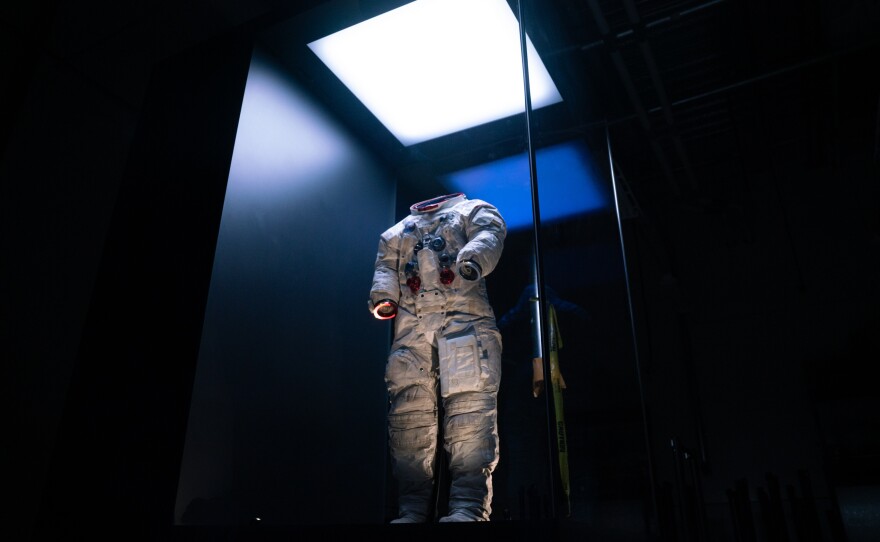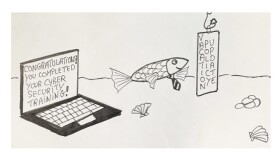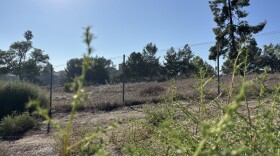Don't see the video above? Click here.
When astronaut Neil Armstrong first stepped on the moon 50 years ago, it was a giant leap for functional fashion.
The spacesuit he wore was an unprecedented blend of technology and tailoring.
"The suit itself is an engineering marvel," says Malcolm Collum, the chief conservator for the Smithsonian's National Air and Space Museum. "Every single thing on here is a specific function. It is engineered to the last little detail."
Take the metal fittings that connect the helmet, air tubes and gloves. They're brightly colored — for example, vivid red metal for the right glove, neon blue for the left. Patriotic, yes, but also exceptionally functional. That's because NASA wanted to make sure that in all of the excitement of landing on the moon, Armstrong was able to easily connect his gear.
And that attention to detail is evident from helmet to toe. The stitching throughout is meticulous — much of it done by hand in 1969. The suit had to be tough, flexible and airtight. Armstrong's life depended on a finely guided needle and thread.
But decades of being on display throughout the country took a toll. In 2006, Smithsonian technicians noticed Armstrong's spacesuit was showing signs of age. So they removed it from the Air and Space Museum in Washington, moved it to a storage facility and laid it out in a drawer.
Collum and his team of technicians have had the job of getting Armstrong's spacesuit standing tall and back on public view again.
It's been a four-year, $700,000 preservation effort. Collum and his team at the Air and Space Museum's Udvar-Hazy Center, a Smithsonian outpost a few miles outside of Washington, cleaned and repaired the inside and outside of the spacesuit, then fitted it to a specially designed mannequin and placed it in a temperature-controlled case. The suit goes back on display at the Air and Space Museum in Washington on July 16, the day 50 years ago that Apollo 11 blasted off for the moon.
The team's job, Collum says, has been more about conservation than restoration. The Smithsonian is not trying to make the spacesuit as pristine as the day it was made.
"We're not removing any original material. We're not replacing any materials that might be now deteriorated or missing," he says. "We're really trying to say that what the visitors are seeing here is exactly what they saw back in 1969."
For the most part, the outside of the suit has held up pretty well. There were a few rips and tears on fabric and some were fixed. Much of the deterioration has taken place on the inside.
The spacesuit is made of 21 layers of fabric, rubber, metal and fiberglass. It was made to be airtight and tough enough to prevent punctures from micrometeorites, which are tiny particles of dust hurtling through space at incredible speeds. Collum says time is now its biggest threat.
"A lot of these materials were designed with the life expectancy of about six months," he says. "And after that, NASA didn't care because they knew the suit was not going to be reused again. Here we are 50 years later trying to make sure that these materials last for the next several generations."
Before technicians got to work, they did extensive X-rays and 3D scanning of the spacesuit. It allowed them to assess what needed to be done to preserve it. They concluded that the internal rubber and plastic parts had begun to crumble because of a buildup of harmful vapors. There was not much that could be done to repair the damage, but technicians were able to slow the deterioration by creating a specially designed mannequin that channels a constant stream of fresh air throughout the suit.
The mannequin that now wears the suit is built to preserve its internal rubber and plastic parts.
"Like all materials, they eventually degrade, and plastics and rubbers do a little faster than other materials. And so with that in mind, we've devised the mannequin so it not only provides structural support but it's also a fresh-air delivery system," he says. "So any sort of harmful vapors that the suit materials off-gas will be eventually pushed out of the suit and will not be allowed to sort of fester in there and cause additional damage."
The suit is now positioned with the left leg slightly forward — as if it were about to take that first small step for man. The pose makes the suit feel alive, Collum says.
"Oftentimes you see spacesuits or flight suits or any kind of uniform just sort of standing there looking straightforward, arms to their sides, just anonymous, featureless," he says. "But the suit really has a vibrance to it, a real presence."
And the suit still looks like it's been to the moon and back. As your eyes scan down — below the red metal ring where the helmet screws on, below the American flag on the shoulder, below the eagle on the Apollo 11 mission patch and below where Armstrong's name is stitched on — the white fabric gradually turns gray. The thighs, knees and boots are stained with lunar dust.
"When people see it and they know where it's been and what it did and who wore it," he says. "It really just makes such a powerful experience."
In 1994, on the 25th anniversary of his stroll through that dust, Armstrong wrote a letter to the team that created his spacesuit. He commented on the suit's function and fashion. He joked that it was successful in part because it hid from view "its ugly occupant." Its true beauty, he wrote, "was that it worked. It was tough, reliable and almost cuddly. To all of you who made it all that it was ... thanks and congratulations."
Copyright 2019 NPR. To see more, visit https://www.npr.org.






